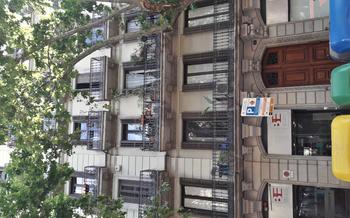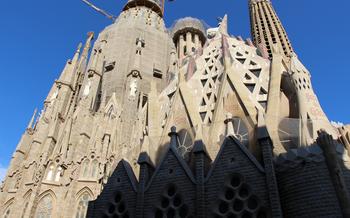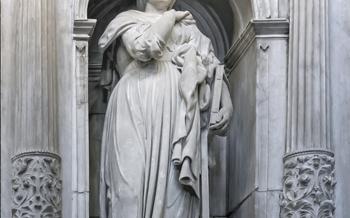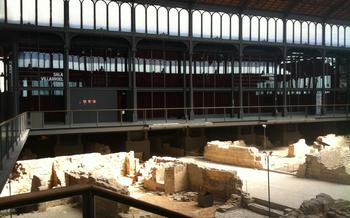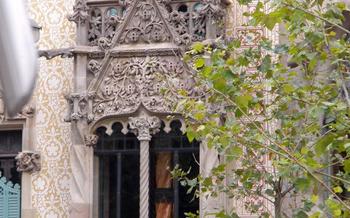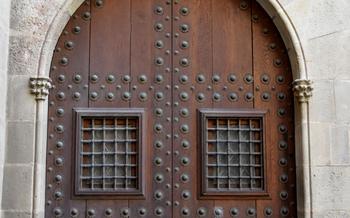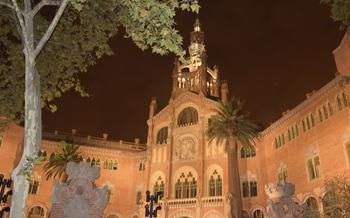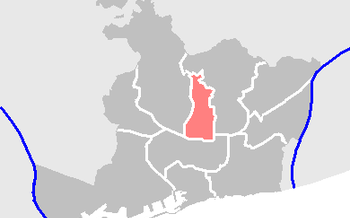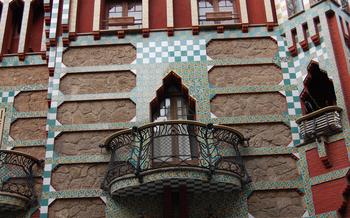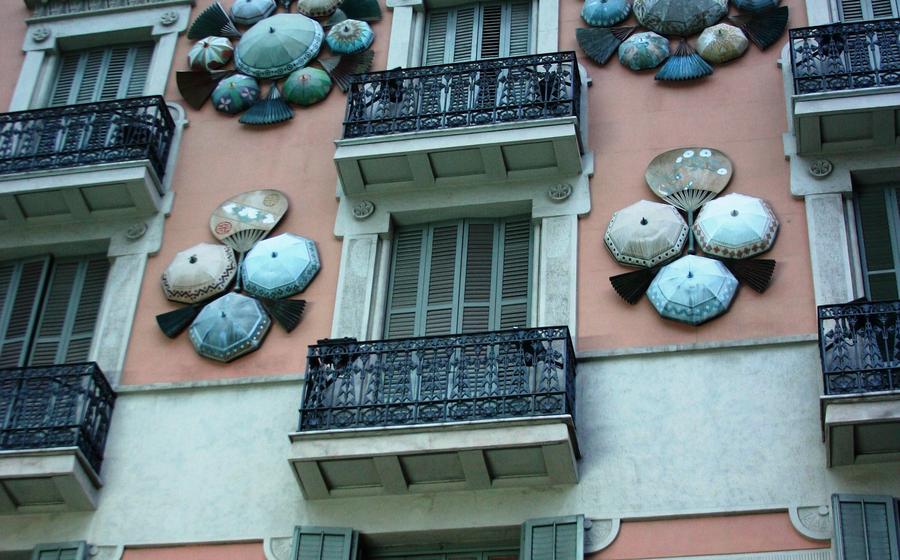
Casa Bruno Cuadros
- Casa Bruno Cuadros: A Hidden Gem in Barcelona
- Exploring the Casa Bruno Cuadros
- Immerse Yourself in Art and History
- Discover the Work of Bruno Cuadros
- Transport to Casa Bruno Cuadros
- Plan Your Visit
- Capture the Beauty
- Local Insights
- Step Back in Time
- Off-the-Beaten-Path Experiences
- Follow in the Footsteps of History
- Embrace the Catalan Culture
- Get Lost in the Labyrinthine Streets
- People-Watching Paradise
- Insider Tip: Hidden Rooftop Terrace
Casa Bruno Cuadros: A Hidden Gem in Barcelona
Nestled in the heart of Barcelona's bustling Eixample district, the Casa Bruno Cuadros stands as a testament to the city's rich architectural heritage. Built in the late 19th century by the renowned architect Lluís Domènech i Montaner, this hidden gem boasts a unique blend of Gothic and Renaissance Revival styles, making it a captivating sight to behold. The Casa Bruno Cuadros is not just a architectural masterpiece, but also holds significant historical and cultural value. Originally commissioned by the wealthy textile merchant Bruno Cuadros, the building served as a residential palace for the Cuadros family. Over the years, it has undergone several transformations, including a brief stint as a school, before being meticulously restored to its former glory. Today, the Casa Bruno Cuadros stands as a vibrant cultural hub, hosting exhibitions, events, and workshops that celebrate Barcelona's rich artistic and cultural heritage.
Exploring the Casa Bruno Cuadros
Immerse yourself in the captivating world of Casa Bruno Cuadros through guided or self-guided tours. Guided tours, available at specific times, offer an in-depth exploration of the building's history, architecture, and artistic significance. Advance booking is recommended to secure your spot.
For a more independent experience, embark on a self-guided tour. Explore the building at your own pace, taking in the intricate details and admiring the unique design elements. Be sure to visit the main hall, the grand staircase, and the stunning rooftop terrace, offering breathtaking panoramic views of Barcelona.
Highlights of the Casa Bruno Cuadros include the exquisite stained glass windows, intricate tile work, and ornate carvings that adorn the building's facade and interior. Don't miss the impressive collection of paintings, sculptures, and furniture that showcase the artistic prowess of Bruno Cuadros and his contemporaries.
Immerse Yourself in Art and History
The artistic significance of the Casa Bruno Cuadros lies in its intricate details and symbolism. From the elaborate facade to the interior frescoes, the building showcases a blend of architectural styles and artistic influences. Visitors can delve into the historical context of the building by learning about the role it played in Barcelona's past. The building once served as a textile factory, reflecting the city's industrial heritage. Today, it stands as a testament to the city's cultural and artistic transformation. Exhibitions and events are regularly held within the Casa Bruno Cuadros, offering visitors an opportunity to engage with contemporary art and cultural expressions. These events range from art installations and workshops to concerts and performances, creating a dynamic and vibrant space for artistic exploration. Planning your visit to coincide with an exhibition or event allows you to immerse yourself fully in the artistic and cultural offerings of the Casa Bruno Cuadros.
Discover the Work of Bruno Cuadros
Bruno Cuadros: Born in 1847 in the heart of Barcelona, Bruno Cuadros emerged as a visionary architect who left an indelible mark on the city's architectural landscape. His artistic journey began at a young age, nurtured by the vibrant cultural scene of Barcelona. Inspired by the works of renowned Catalan architects like Antoni Gaudí and Lluís Domènech i Montaner, Cuadros developed a unique style that blended traditional Catalan elements with innovative design principles.
Artistic Style: Cuadros's architectural style was characterized by its eclecticism, drawing influences from various artistic movements, including Neo-Gothic, Modernism, and Art Nouveau. He masterfully incorporated intricate details, decorative elements, and colorful tiles into his designs, creating buildings that were both visually stunning and structurally sound.
Notable Works: Among Cuadros's most notable works is the Casa Bruno Cuadros, a residential building that epitomizes his artistic vision. Completed in 1902, the building showcases his signature style with its elaborate facade, ornate balconies, and colorful ceramic tiles. Other notable works include the Casa de les Punxes, a spectacular building with six pointed towers, and the Palau de la Música Catalana, a concert hall renowned for its exquisite acoustics and stunning stained-glass windows.
Cuadros's Legacy: Bruno Cuadros's contributions to Barcelona's architectural heritage are immense. His buildings continue to captivate visitors with their beauty and craftsmanship, serving as a testament to his creative genius. His work played a pivotal role in shaping the city's architectural identity, making him one of the most celebrated architects of his time.
Transport to Casa Bruno Cuadros
The Casa Bruno Cuadros is situated at Carrer de Montcada, 20, in the heart of Barcelona's historic El Born district. The building is conveniently accessible via public transportation, providing visitors with various options to reach the site.
The closest metro station is Jaume I, served by Line 4 (yellow line). From the station, it's a short walk of approximately 5 minutes to the Casa Bruno Cuadros. Alternatively, visitors can take any of the following bus routes: 14, 17, 39, 40, 45, 51, 120, H14, V13, V17, or V19, which stop within a short walking distance from the building.
For those arriving by tram, the nearest stop is Pla de Palau, served by Line 4 (yellow line). From the tram stop, it's a leisurely 7-minute walk to the Casa Bruno Cuadros.
The building is wheelchair accessible, ensuring that visitors with disabilities can comfortably explore the premises. A dedicated wheelchair ramp is available at the entrance, and elevators provide access to all floors of the Casa Bruno Cuadros.
Plan Your Visit
Casa Bruno Cuadros welcomes visitors with open arms, inviting them to explore its architectural wonders and immerse themselves in its artistic legacy. To ensure a seamless and fulfilling experience, plan your visit meticulously.
Opening Hours and Admission Fees:
The Casa Bruno Cuadros is open to the public from Tuesday to Sunday, with varying hours of operation. It opens its doors from 10:00 AM to 6:00 PM on weekdays, while on weekends, it extends its hours from 10:00 AM to 8:00 PM. Admission fees are reasonably priced, offering great value for the cultural experience. The standard ticket price is set at 10 euros, while concessions are available for students, seniors, and families.
Best Time to Visit:
To avoid the throngs of visitors and fully appreciate the Casa Bruno Cuadros' charm, plan your visit during the shoulder seasons, namely spring and autumn. During these periods, the weather is pleasant, and the crowds are fewer, allowing you to savor the building's intricacies without feeling rushed.
Duration of Visit:
Set aside at least two hours to comprehensively explore the Casa Bruno Cuadros. This duration allows you to leisurely wander through the rooms, admire the architectural details, delve into the exhibitions, and soak in the artistic ambiance. The building's compact size ensures that you won't feel overwhelmed, yet its rich history and artistic offerings provide ample opportunities for exploration.
Capture the Beauty
Casa Bruno Cuadros offers a feast for the eyes, making it a photographer's paradise. While capturing the essence of this architectural masterpiece, it's essential to adhere to the rules and guidelines set by the management. Flash photography is strictly prohibited, as it can damage the delicate artworks and interiors. Tripods are also not allowed, ensuring that visitors can move around freely without obstruction.
For Instagram enthusiasts, the Casa Bruno Cuadros presents a plethora of photo opportunities. The intricate details of the facade, the vibrant colors of the stained glass windows, and the elegant curves of the interior architecture provide endless possibilities for capturing stunning shots. Don't miss the chance to capture the essence of this hidden gem and share it with the world.
Local Insights
The Casa Bruno Cuadros is nestled in a vibrant neighborhood that is rich in history and local culture. Take some time to explore the surrounding area and discover hidden gems that offer a glimpse into the authentic Barcelona experience.
For a culinary adventure, venture into the nearby streets and savor the flavors of traditional Catalan cuisine. From cozy tapas bars to Michelin-starred restaurants, there are options to suit every taste and budget. Indulge in mouth-watering dishes such as paella, patatas bravas, and crema catalana, all while soaking up the lively atmosphere of the local dining scene.
For a unique shopping experience, explore the charming boutiques and artisan workshops that line the narrow streets. Discover one-of-a-kind crafts, ceramics, and jewelry made by local artists and artisans. These shops offer a wonderful opportunity to support local talent and take home a piece of Barcelona's creative spirit.
As you wander through the neighborhood, keep an eye out for hidden plazas and courtyards. These tranquil spots offer a respite from the bustling city and provide a glimpse into the private lives of Barcelona's residents. Take a moment to relax on a bench, soak up the sun, and observe the locals going about their daily lives.
Step Back in Time
The neighborhood surrounding the Casa Bruno Cuadros is steeped in history, with stories and anecdotes from the past that bring the area to life. Wander through the narrow streets and discover hidden plazas, each with its own unique charm. Admire the diverse architectural styles, from medieval churches to modernist masterpieces, that reflect the neighborhood's rich heritage. Let the buildings whisper tales of bygone eras, as you step back in time and immerse yourself in the vibrant history of Barcelona.
Off-the-Beaten-Path Experiences
Venture beyond the Casa Bruno Cuadros to discover the hidden gems that make this neighborhood so special. Unique shops and boutiques line the charming streets, showcasing local crafts and artisan products that reflect the vibrant culture of Barcelona. From handmade ceramics and jewelry to vintage clothing and upcycled treasures, these shops offer a glimpse into the creativity and artistry of the local community.
As you wander further, you'll stumble upon hidden plazas and courtyards, tucked away from the bustling streets. These tranquil spots provide a welcome respite from the crowds, inviting you to relax and soak in the peaceful atmosphere. Enjoy a picnic lunch surrounded by lush greenery, or simply sit on a bench and watch the world go by.
Follow in the Footsteps of History
The neighborhood surrounding Casa Bruno Cuadros is steeped in history, attracting famous figures from various walks of life. One notable resident was the renowned architect Antoni Gaudí, whose influence can still be seen in the neighborhood's architectural marvels. From his iconic Sagrada Familia to the whimsical Park Güell, Gaudí's legacy is woven into the fabric of the area.
Literary giants have also graced the streets of this historic neighborhood. The renowned author and philosopher, Josep Pla, often sought inspiration within its charming cafes and tranquil plazas. His writings vividly capture the essence of the neighborhood, providing a glimpse into its past through the eyes of a master storyteller.
Beyond architecture and literature, the neighborhood has also been a muse for artists. The surrealist painter Joan Miró had a studio nearby, where he created some of his most captivating works. His influence can still be felt in the neighborhood's vibrant art scene, with galleries and studios showcasing the works of contemporary artists.
Embrace the Catalan Culture
Barcelona is a city that embraces its Catalan culture with pride. The city's unique language, cuisine, and traditions are celebrated throughout the year, offering visitors a chance to immerse themselves in the local way of life.
One of the best ways to experience Catalan culture is through its festivals and events. The city hosts a variety of celebrations throughout the year, including the world-famous La Mercè festival in September, which features parades, concerts, and fireworks. Other popular festivals include the Three Kings Parade in January, the Carnival in February, and the Festa Major de Gràcia in August.
Catalan cuisine is another highlight of the city. The region's dishes are known for their use of fresh, local ingredients and their bold flavors. Some of the most popular dishes include paella, a rice dish with seafood and vegetables; escudella i carn d'olla, a meat and vegetable stew; and crema catalana, a custard dessert.
Visitors can also learn about Catalan culture by visiting the city's many museums and galleries. The Museu Nacional d'Art de Catalunya houses a collection of Catalan art from the Middle Ages to the present day, while the Museu Picasso showcases the work of the famous Catalan artist Pablo Picasso.
By immersing themselves in Catalan culture, visitors to Barcelona can gain a deeper understanding of the city and its people. From attending festivals and events to sampling the local cuisine and visiting the city's museums, there are many ways to experience the vibrant culture of Catalonia.
Get Lost in the Labyrinthine Streets
The Gothic Quarter is a maze of narrow, winding streets, hidden plazas, and courtyards that invite you to get lost and explore. There are no shortage of things to see and do in this historic neighborhood, from visiting the many churches and museums to simply wandering around and soaking up the atmosphere. Take a leisurely stroll through the streets and you may stumble upon a hidden treasure, such as a small art gallery, a charming boutique, or a secluded cafe. Getting lost in the Gothic Quarter is half the fun, so don't be afraid to wander off the beaten path and see where your feet take you.
Embrace the unexpected and let the Gothic Quarter work its magic on you. Around every corner, there's a new surprise waiting to be discovered. Enjoy the feeling of being lost in a foreign city and let yourself be captivated by the beauty and history of the Gothic Quarter.
People-Watching Paradise
For a truly immersive experience, don't miss the opportunity to relax at one of the charming cafes or terraces that line the streets surrounding Casa Bruno Cuadros. These inviting spots offer the perfect vantage point for observing local life unfold, sipping a refreshing beverage, and soaking up the vibrant atmosphere of Barcelona.
As you sit back and unwind, you'll be treated to a parade of colorful characters, from stylish locals to wide-eyed tourists, all adding to the unique tapestry of this vibrant city. Keep an eye out for street performers and musicians who often entertain passersby with their impromptu performances, creating a lively and unforgettable ambiance.
Embrace the laid-back pace of life in Barcelona and let the hours slip away as you immerse yourself in the sights, sounds, and aromas of this captivating city. People-watching in Barcelona is an art form, and there's no better place to indulge in this delightful pastime than in the charming neighborhood surrounding Casa Bruno Cuadros.
Insider Tip: Hidden Rooftop Terrace
Venturing beyond the main exhibition spaces of Casa Bruno Cuadros, there lies a hidden gem that offers a breathtaking perspective of Barcelona's cityscape. Ascend the discreet staircase tucked away in a corner of the building, and you'll find yourself on a secluded rooftop terrace, a secret oasis amidst the bustling urban landscape.
This hidden haven provides a panoramic vista that stretches across the city's architectural tapestry, from the Gothic spires of the Sagrada Familia to the modern skyscrapers that define the skyline. Take a moment to soak in the beauty of Barcelona from this unique vantage point, capturing the essence of the city's vibrant energy and diverse character.
To access this hidden rooftop terrace, inquire discreetly with the Casa Bruno Cuadros staff. They'll gladly provide directions and ensure you have a safe and memorable experience. Remember to bring your camera to capture the stunning views and share your unique perspective of Barcelona with the world.
